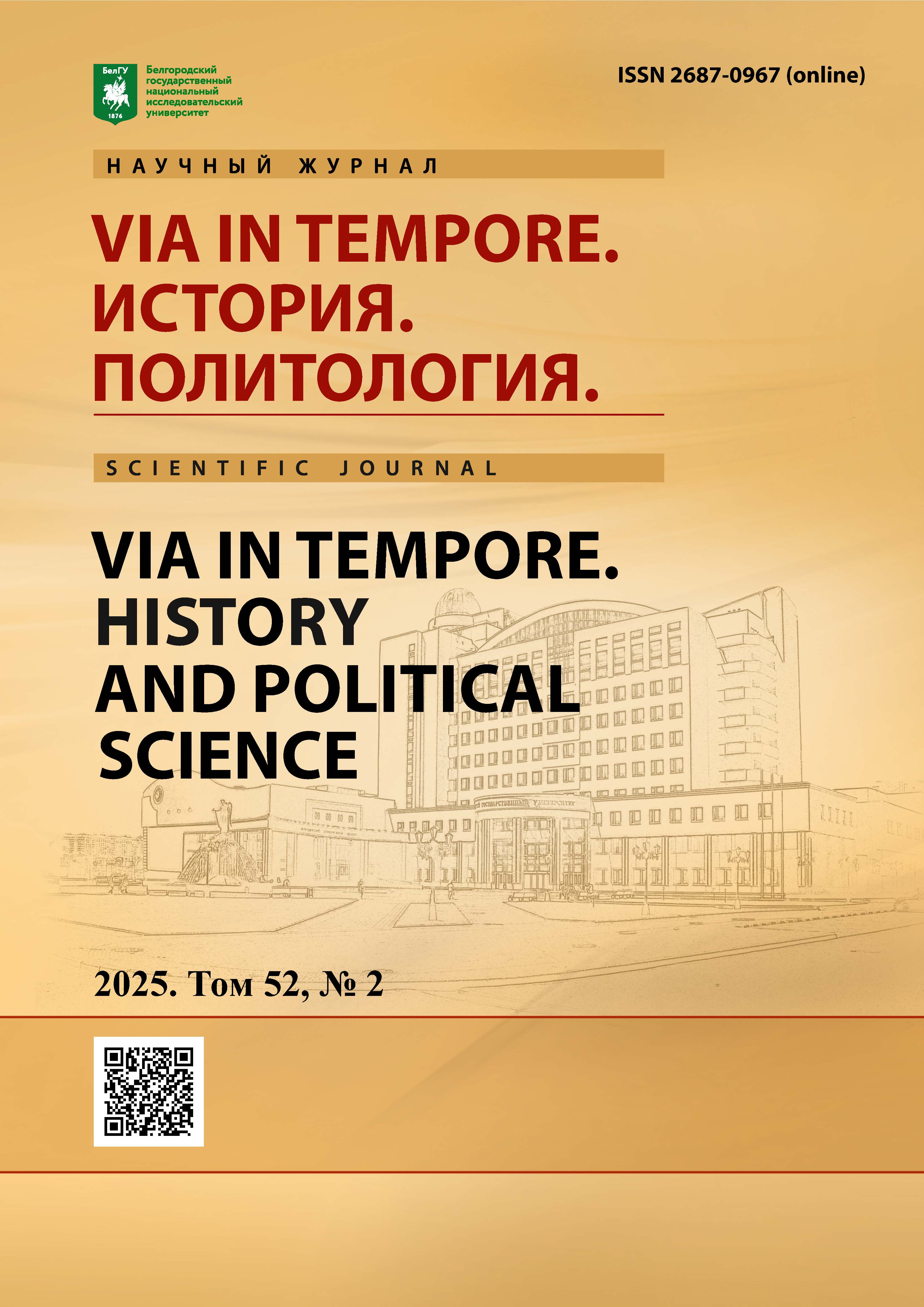Роль Кипрской церкви в религиозной политике императора Ираклия
DOI:
https://doi.org/10.52575/2687-0967-2025-52-2-316-321Ключевые слова:
поздняя Античность, ранняя Византия, Кипр, монофиситы, император ИраклийАннотация
Статья посвящена анализу роли и участию епископов церкви Кипра в религиозной политике византийского императора Ираклия (610–641 гг.). В условиях сложной внутриполитической ситуации, связанной со свержением императора Фоки и внешней угрозы со стороны Сасанидского Ирана, Кипрская церковь, которая до данного момента почти не была задействована в богословских спорах и конфликтах, стала важным инструментом правительства нового императора по проведению своей церковной политики в отношении монофиситов. Её виднейшие представители из-за своего влияния и авторитетного положения автокефальной церкви были привлечены как посредники в решении достаточно важных и трудных ситуаций, с которыми столкнулся Ираклий.
Скачивания
Библиографические ссылки
Список литературы
Болгов Н.Н. 2022. Саламин Кипрский: история и топография в римское и ранневизантийское время. В: Via et tempore. История. Политология. Т. 49(3). Белгород: 535–555.
Болотов В.В. 1918. Лекции по истории древней церкви. Т. 4. Петроград, Третья государственная типография, 600.
Винкельман Ф. 1986. Положение Египта в Восточноримской (Византийской) империи. В: Византийский временник. Т. 46. Москва: 75–87.
Albert M., Schönborn C. 1978. Lettre de Sophrone de Jerusalem a Arcadius de Chypre. In: Patrologia Orientalis. Т. 39(2). Paris, 86.
Brock S. 1973. An Early Syriac Life of Maximus the Confessor. (3–4). Bruxelles: 299–346.
Chadwik H. 1974. John Moschus and his Friend Sophronius the Sophist. In: Journal of Theological Studies. № 25. Oxford: 41–74.
Cosentio S. 2013. A Longer Antiquity? Cyprus, Insularity and the Economic Transition. In: Cahiers du Centre d’Études Chypriotes. № 43. Lyon: 93–102.
Delehaye H. 1927. Une vie inédite de Saint Jean Laumonier. In: Analecta Bollandiana. T. 45, 74.
Kaegi W. 2003. Heraclius Emperor of Byzantium. Cambridge, Cambridge University Press, 359.
Maspero J. 1923. Histoire des patriarches d'Alexandrie: depuis la mort de l'empereur Anatase jusqu'à la réconciliation des églises jacobites (518–616). Paris, Librairie Ancienne Eduard Champion, 393.
Metcalf D.M. 2009. Byzantine Cyprus 491–1191. Nicosia, Theopress LTD, 656.
Paton W.R. 1917. The Greek Anthology. London, Published by W. Heinemann, 517.
Pattenden P. 1982. Who Was the Father of St. John the Almoner? In: Journal of Theological Studies. № 33. Oxford: 191–194.
Rapp C. 2004. All in the Family: John the Almsgiver, Nicetas and Heraclius. In: Nea Roma. № 1. Roma: 121–134.
Rapp C. 2014. Christianity in Cyprus in the Fourth to Seventh Centuries: Chronological and Geographical Frameworks. In: Stewart C.A., Davis T.A., Carr A.W. Cyprus and the Balance of Empires: Art and Archaeology from Justinian I to the Coeur de Lion. Boston, American schools of Oriental research: 29–38.
Rapp C. 2015. Cypriot Hagiography in the Seventh Century: Patrons and Purpose. In: Γιακου Θ., Νασσις Σ. ΚΥΠΡΙΑΚΗ ΑΓΙΟΛΟΓΙΑ. Παραλιμνι, Ιερα Μητροπολις Κονσταντιας: 397–411.
Sodini J.P. 1998. Les inscriptions de l’aqueduc de Kythrea à Salamine de Chypre. In: Eupsychia: Mélanges off erts à Hélène Ahrweiler. Paris: 619–633.
Van Dieten J.L. 1972. Geschichte der Patriarchen von Sergios I. bis Johannes VI (610–715). Amsterdam, Verlag Adolf M. Hakkert, 241.
Woods D. 2016. Reading the Consular Solidi of the Revolt of the Heraclii, 608–610. In: Schweizerische numismatische Rundschau. № 95. Bern: 83–96.
References
Bolgov N.N. 2022. Salamin Kiprskij: istoriya i topografiya v rimskoe i rannevizantijskoe vremya [Salamis of Cyprus: History and Topography in Roman and Early Byzantine Times]. Via et tempore. History. Political science. T. 49(3). Belgorod: 535–555.
Bolotov V.V. 1918. Lekcii po istorii drevnej cerkvi [Lectures on the History of the Ancient Church]. T. 4. Petrograd, Tret`ya gosudarstvennaya tipografiya, 600.
Vinkel`man F. 1986. Polozhenie Egipta v Vostochnorimskoj (Vizantijskoj) imperii [The Position of Egypt in the Eastern Roman (Byzantine) Empire]. Vizantijskij vremennik [Byzantine Timetable]. T. 46. Moskva: 75–87.
Albert M., Schönborn C. 1978. Lettre de Sophrone de Jerusalem a Arcadius de Chypre. In: Patrologia Orientalis. Т. 39(2). Paris, 86.
Brock S. 1973. An Early Syriac Life of Maximus the Confessor. (3–4). Bruxelles: 299–346.
Chadwik H. 1974. John Moschus and his Friend Sophronius the Sophist. In: Journal of Theological Studies. № 25. Oxford: 41–74.
Cosentio S. 2013. A Longer Antiquity? Cyprus, Insularity and the Economic Transition. In: Cahiers du Centre d’Études Chypriotes. № 43. Lyon: 93–102.
Delehaye H. 1927. Une vie inédite de Saint Jean Laumonier. In: Analecta Bollandiana. T. 45, 74.
Kaegi W. 2003. Heraclius Emperor of Byzantium. Cambridge, Cambridge University Press, 359.
Maspero J. 1923. Histoire des patriarches d'Alexandrie: depuis la mort de l'empereur Anatase jusqu'à la réconciliation des églises jacobites (518–616). Paris, Librairie Ancienne Eduard Champion, 393.
Metcalf D.M. 2009. Byzantine Cyprus 491–1191. Nicosia, Theopress LTD, 656.
Paton W.R. 1917. The Greek Anthology. London, Published by W. Heinemann, 517.
Pattenden P. 1982. Who Was the Father of St. John the Almoner? In: Journal of Theological Studies. № 33. Oxford: 191–194.
Rapp C. 2004. All in the Family: John the Almsgiver, Nicetas and Heraclius. In: Nea Roma. № 1. Roma: 121–134.
Rapp C. 2014. Christianity in Cyprus in the Fourth to Seventh Centuries: Chronological and Geographical Frameworks. In: Stewart C.A., Davis T.A., Carr A.W. Cyprus and the Balance of Empires: Art and Archaeology from Justinian I to the Coeur de Lion. Boston, American schools of Oriental research: 29–38.
Rapp C. 2015. Cypriot Hagiography in the Seventh Century: Patrons and Purpose. In: Γιακου Θ., Νασσις Σ. ΚΥΠΡΙΑΚΗ ΑΓΙΟΛΟΓΙΑ. Παραλιμνι, Ιερα Μητροπολις Κονσταντιας: 397–411.
Sodini J.P. 1998. Les inscriptions de l’aqueduc de Kythrea à Salamine de Chypre. In: Eupsychia: Mélanges off erts à Hélène Ahrweiler. Paris: 619–633.
Van Dieten J.L. 1972. Geschichte der Patriarchen von Sergios I. bis Johannes VI (610–715). Amsterdam, Verlag Adolf M. Hakkert, 241.
Woods D. 2016. Reading the Consular Solidi of the Revolt of the Heraclii, 608–610. In: Schweizerische numismatische Rundschau. № 95. Bern: 83–96.
Просмотров аннотации: 80
Поделиться
Опубликован
Как цитировать
Выпуск
Раздел
Copyright (c) 2025 Via in tempore. История. Политология

Это произведение доступно по лицензии Creative Commons «Attribution» («Атрибуция») 4.0 Всемирная.


